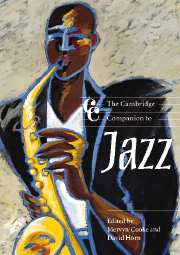1 - The identity of jazz
from Part One - Jazz times
Published online by Cambridge University Press: 28 September 2011
Summary
Among the many historical accounts of jazz, it is above all the discographies that convey most graphically and emphatically just how extensively performed and how diverse jazz has been since it arrived on the public scene in 1916–17. But it is beyond the brief of a discography to do much more than list, and so the nearest thing we have to a record of the sheer scale of jazz diversity and inventiveness is silent on many other questions. Thus, while many discographies take for granted that the diversity they chronicle represents a collective body of music – even if they appear to have built into them particular views of what is and is not ‘jazz’ – they do not see it as their task to identify what, if anything, might connect the music together (and how and why), even less to consider the question of how the achievements they enumerate belong in, reflect and respond to a wider world. And there is no particular reason why they should. But if we seek to go beyond diversity and extent and look for what made jazz distinctive, we need to ask questions such as: how did jazz acquire its identity in the twentieth century, how was that identity constructed, and what role was played in the formation of identity by the ways in which the music was connected to processes and histories both close to and beyond its immediate environment?
- Type
- Chapter
- Information
- The Cambridge Companion to Jazz , pp. 7 - 32Publisher: Cambridge University PressPrint publication year: 2003
- 2
- Cited by



